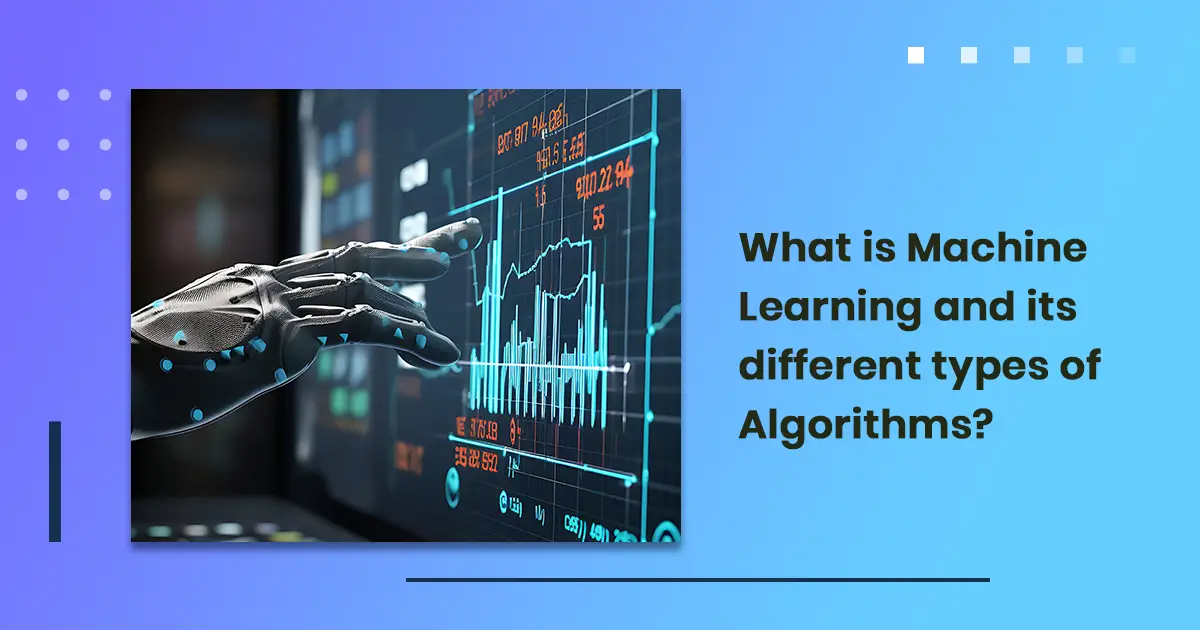
What is Machine Learning and its different types of Algorithms?
Dec 29, 2023
Artificial Intelligence is an academic discipline founded in the early 1950s. During World War II, mathematician Alan Turing's effort for code breaking German ‘Enigma’ machine was successful. His ‘Turing test’ gave us the first image of ‘Artificial intelligence’ to ascertain if computers have real intelligence.
Machine Learning is a subset of Artificial Intelligence. Arthur Samuel coined the term Machine Learning in 1959. He defined it as “The field of study that gives computers the capability to learn without being explicitly programmed”.
Machine Learning, algorithms use statistics to find patterns from the massive data and make predictions. The data is manifold comprising numbers, words, images etc. The task we need to do is feed the digital data in the machine learning algorithms.
Business leaders sought the help of ML for prediction and decision making. In reality, without our knowledge machine learning has already started influencing our daily lives. It
- Recommends movies for viewing through OTT platforms like Netflix etc.
- Express opinions through social media sites like facebook etc.
- Assists through voice associates like Alexa etc.
- Explore prospects through search engines like Google, Bing etc.
Different types of machine learning algorithms:
As we now know what machine learning is, we need to understand the different types of algorithms it uses.
1. Supervised learning:
Supervised learning is one of the most basic types of machine learning. It is widely used in applications involving historical data. This pattern recognition model of learning involves methods of classification, regression, and prediction.
The machine learning algorithm is trained through labeled data. It receives sets of inputs along with the corresponding sets of correct outputs. The algorithm finds a cause-and-effect relationship between the variables given in the dataset.
The algorithm now has an idea of how the data functions and the relationship between the input and output received. It pursues improvising even after deployment, identifying new models, and building the relationship on the new set of data.
Supervision learning can be sorted into three groups:
- Classification: Sorting output into categories – e.g. Activating a spam filter in our email. The program reads the email and classifies them as spam or non-spam based on its content.
- Regression: Returns an output that can be measured. Eg. How many hours of travel are required to reach the destination, using different modes of transport? This outcome is reached through the regression algorithm.
- Prediction: With the available data, it can be foreseen when credit card transactions are likely to be deceitful or which insurance customer is likely to file a claim.
2. Un-supervised learning:
Un-supervised learning does not rely on historical data. Therefore, the human effort is saved from labeling data to create a relationship between the input and correct output.
The advantage is being able to work with unlabeled data. The goal is to explore the data and find some structure within. This versatility helps to build relationships between the data points and interpret in an abstract manner.
This works well on transaction data. For example, identification of common customers having similar tastes or attributes. These algorithms suggest topics, recommend items etc.
Un-supervision learning can be sorted into two groups:
Clustering: is to find a particular group within a dataset. For eg. finding the age group and their profession / income distribution.
Association: is to find rules or patterns within a dataset. For eg. able to find the customers choices through the website, links etc.
3. Semi-supervised learning:
It is a combination of both types of learning. The data it used is both labeled and unlabeled. For the purpose of cost reduction, a small amount of labeled data is associated with a larger amount of unlabeled data.
Again, this type of data used methods of classification, regression, and prediction. E.g. identification of faces on the webcam.
4. Reinforcement learning:
Reinforcement learning is very similar to our traditional analysis method of applying trial and error methods. It reaches its objectives by trying many things, either it is rewarded or penalized during the process.
With this, the algorithms declare the outcomes with the best possible results.
It comprises of three primary components namely:
- The agent – who plays the role of a learner / decision maker
- The environment – consists of all where the agent interacts
- Actions – things the agent can perform
The objective is for the agent to choose actions giving maximum reward over a given period of time. Further, it adjusts the algorithm as and when it detects error.
We can see this type of learning in the fields of robotics, gaming and navigation. Eg Google maps use reinforcement learning.
If you are an accounting firm, interested in applying machine learning or Robotic process automation in your firm, please call us for expert advice. We have readymade robotic and machine learning solutions for accounting firms.
Schedule Your Free Demo
With our accounting automation experts
Find out how other practices have benefited using Integra Balance AI bookkeeping automation. 87% of practices who viewed AI bots in action have instantly discovered the advantages of using them at their firm.
Global Offices
US (Head Quarters)
Integra Global Solutions Corp
7500 Brooktree Road, Suite 100
Wexford (Pittsburgh)
PA 15090
+1 412 267 1529
Philippines
Integra Global Solutions Corp
Ayala Cebu Tower,
Cebu Business park, Cebu 6000
+1 412 267 1529
Europe
Integra Global Solutions UK Ltd
College House
17 King Edwards Road
Ruislip, London, UK, HA4 7AE
+44 (0)20 7993 2949
Canada
Integra Global Solutions Corp
32 Blencathra Hill, Unit 100, Markham
Ontario
+1 412 267 1529
India
Integra Global Solutions Corp
First floor, Kanapathy Towers,
Opp.BSNL exchange, Ganapathy,
Coimbatore – 641 006, India
+91 (0422) 437 9555
Australia
Integra Global Solutions Corp
+61 02 8005 1836
